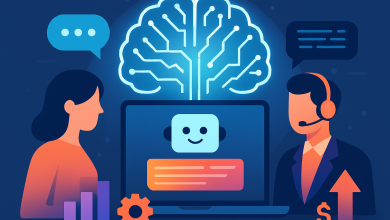
Implementing AI is challenging – far more so than the glossy vendor demos and hyped success stories make out. For every headline about AI transforming an industry, there are many untold stories of initiatives that quietly fizzle out. In fact, nearly half of AI proof-of-concept projects never even make it to production. Companies big and small are urged to jump on the bandwagon, only to hit a wall when pilot projects can’t scale or fail to deliver meaningful results.
Perhaps the confusion comes from the fact that launching a basic AI pilot is relatively easy; you just need a cloud service, run some data through a pre-built model, and there’s your demo. But scaling that pilot into a robust, secure, integrated production system is an entirely different ballgame.
Before blaming the technology, organisations need to take a hard look in the mirror. More often than not, the problems are internal – a lack of preparation and adaptability within the company itself.
Key barriers holding back AI at scale
The same few core issues tend to surface when it’s time to scale beyond a pilot.
First is the talent gap. While building a prototype may only require a few skilled individuals, scaling AI takes a much broader team of engineers, data scientists, and MLOps specialists, often in short supply. Without this depth of expertise, AI projects are dead on arrival.
Businesses may not be realising – or perhaps they don’t want to acknowledge – just how essential a dedicated AI team is. It’s a huge investment, at a time where countless products are touting immediate gains and leading whole industries to believe that advanced AI capabilities can come straight out of the box, so it’s understandably a hard pill to swallow. But it’s true.
This isn’t just about hiring AI specialists. It’s about transforming the organisation as a whole – upskilling, reskilling, and helping teams to adapt culturally. Becoming an AI-native or AI-driven business requires a shift in mindset and ways of working that can often clash with legacy systems and processes.
This might be why businesses are failing to plan. Companies are launching AI efforts without clear goals,allocated resources or transformation strategies, and the results often fail to address real needs. When time comes to scale, there’s no compelling case to move forward.
The reality is that AI isn’t a fairy godmother that can transform the way businesses work just by being there – a lot of the legwork has to come before the AI, to establish the infrastructure it needs. AI needs iterative, agile development to deliver consistent results, but many organisations still operate within siloed departments and slow, hierarchical processes. Even the most promising AI projects can easily break down when they hit legacy systems.
As well as their systems, organisations must also prepare their people. Changing long-standing habits, evolving skillsets and encouraging cross-functional is just crucial to success as the tech is.
In the end, most AI project failures aren’t about the tech: they’re about the organisation’s ability to adapt. The biggest challenge isn’t the AI itself. It’s integrating it into your processes, your teams, and your company culture.
Laying strong foundations for AI projects
A clear strategy is the first step to forming a successful AI project. Define your goals, milestones, and deliverables in relation to the data and AI systems you’ll use, all before hiring a team. AI isn’t just another software project; it comes with its own unique challenges, from unpredictable outputs to evolving models, so the development process needs to be flexible and iterative.
Next, make sure you’re working with the right expertise. You need people with deep, verified knowledge to successfully integrate AI into real-world systems: seasoned engineers with years of experience of building scalable, reliable AI infrastructures in the bank.
Remember that AI doesn’t make its own magic – behind every great AI product is a team of brilliant people. So embrace innovative talent when composing teams – for example, combine AI engineers who stay on top of the latest developments with strong data specialists and systems engineers who can bring these cutting-edge capabilities into production. This will take your project from good to great.
Finally, don’t overlook the product manager. They’re essential for aligning the team’s output with business goals, user experience, technological capability, and overall strategy.
Most companies shouldn’t go it alone
Given the sizable investment needed, companies are beginning to realise they don’t need to build every AI system from the ground up.
But a wide variety of external tools can be leveraged to help to bridge gaps in talent and experience – pre-built solutions like Google Cloud Vertex AI or Microsoft’s Azure Machine Learning, for example, can help businesses get up and running without needing to design full systems from scratch. These tools often come with essential components like monitoring, scaling, and integration capabilities already in place, and can give companies a good head start.
Project managers should also consider working with external providers, such as specialist firms or freelancers. This way, rather than investing in internal teams, companies can pay for results, like specific deliverables, milestones, or performance improvements.
While this approach can help companies speed up execution, outsourcing isn’t a replacement for internal expertise, and tools aren’t a substitute for human skill. But by being open to outside expertise and accepting help where they can get it, companies can dramatically increase their chances of success.
Confronting AI challenges head-on
The companies that succeed with AI are those that acknowledge the complexity of their ambitious products from the start. That means being realistic about the challenges – that it will require new skills, new workflows, and probably more time and money than expected. Those who understand these risks will be more receptive to frank discussions about risks, requirements, and long-term commitment.
Mindset is everything for these kinds of projects. You have to start small, plan meticulously and work obsessively to get to a place where the real fun begins – where developers can experiment and discover new use cases without sacrificing reliability or performance. But before you can achieve that level of innovation, your AI project needs to be stable and performing consistently at your desired scale.
Every transformative technology in history has gone through a learning curve in industry: this phase is tough, but it’s also where sustainable success is born. The winners will be the companies that treat AI integration as a strategic, long-term journey, and don’t expect the magic to happen on its own. Rest assured: getting it right is well worth the struggle.





